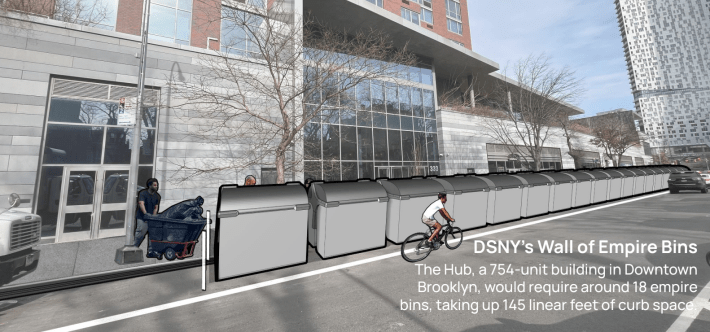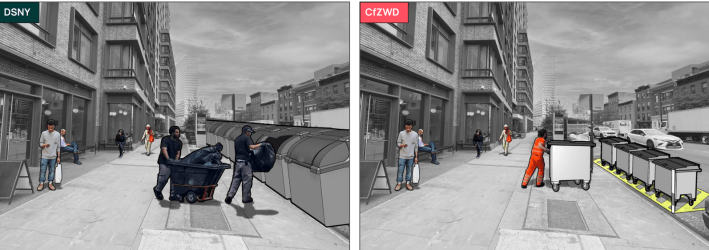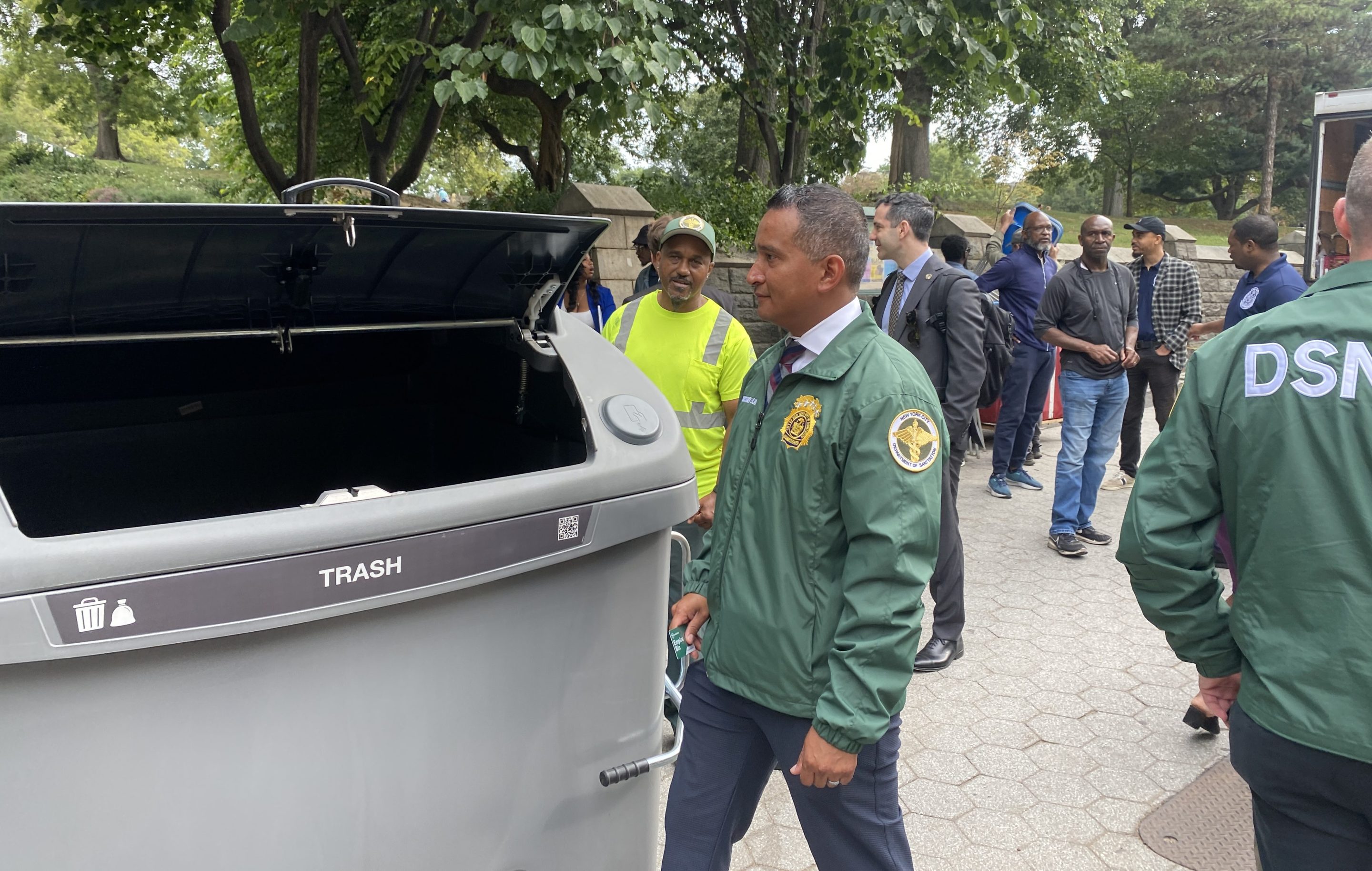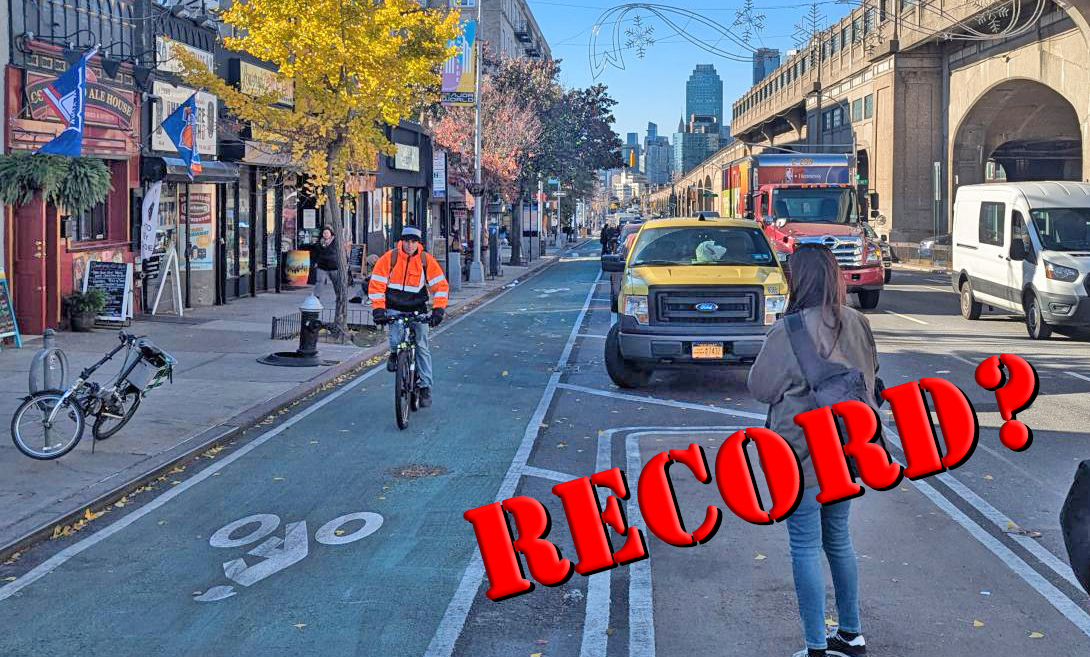The city's push to collect garbage from bins in the street rather than foul heaps of bags on the sidewalk is worth the "sacrifice" of a handful of parking spots, Mayor Adams said on Tuesday, as he announced the Department of Sanitation initiative's expansion into Brooklyn.
"It’s just important for us to realize there’s sacrifices we have to make, and these bins don't take up all the parking spaces, and it's a good trade-off," Adams said in response to a question by Streetsblog at a press conference outside Fort Greene Park. "We want cleaner streets, that's one of the top things we hear."
The comments were a bit out of character for Adams, who has often chosen not to "sacrifice" parking when safety from traffic crashes was the pay-off.
The curbside containers, which DSNY officials call Empire Bins, began rolling out in Upper Manhattan earlier this year, and will come to schools in Fort Greene and Clinton Hill this fall and the rest of Brooklyn Community Board 2 next year when DSNY acquires more custom-built side-loader collection trucks.
Under Adams, the agency has slowly elevated the Big Apple's trash collection to the level of global cities like Buenos Aires or Madrid, starting in uptown Manhattan's Community Board 9 — first with a pilot of wheeled bins in the street in 2023, followed by the stationary curbside Empire Bins this year for large buildings with 31 or more units.
Owners of mid-size housing with between 10 and 31 units get to choose between either wheeled bins on the sidewalk or Empire Bins in the street. Smaller buildings with one to nine units have had already to use wheelie bins on the sidewalk citywide since last November.
Tall order
The zone announced on Tuesday — Fort Greene, Clinton Hill, Brooklyn Heights, Downtown Brooklyn, DUMBO, Boerum Hill and Vinegar Hill — has taller and denser housing stock than in the initial uptown area, especially around Downtown Brooklyn, which has tall skyscrapers to rival Midtown Manhattan.
That will make it more "challenging" to fit all the trash that residents of those bigger buildings generate in the stationary street-side bins, DSNY Acting Commissioner Javier Lojan acknowledged.
"Some of them are going to be a lot bigger than [Manhattan] CB9. We’ll have to work with our team to come up with different strategies on that," Lojan told Streetsblog. "Some of them are going to be a little bit challenging, but we’ll find a solution."
To fit all the trash that residents of some of the largest buildings produce, the agency would have permanently fill up much of the curb with Empire Bins, experts warned.

Instead, the city should switch to large wheeled dumpsters that building staff can roll out straight from a development's trash chute and stage temporarily at designated curb spaces, advised Claire Miflin, the executive director of the Center for Zero Waste Design. These spaces could serve additionally as delivery microhubs or passenger drop off at other times.
"This is mono-functional, and taking this public space permanently with these big new buildings that don’t need it, seems a waste," Miflin said.
DSNY's study of waste containerization from 2023 estimated about 11 percent of the city's housing stock would be too dense to containerize garbage without taking up more than 25 percent of the curb. But that analysis still included recyclables, which agency officials has since decided to leave out of the Empire Bin project.

Miflin noted that large buildings currently collect their garbage from interior chutes and roll them out already anyway, so staging bins in the street would reduce the extra labor of workers having to lift the trash out and into Empire Bins, Miflin noted.
"It’s not good for building labor to be lifting hundreds of bags, they’re heavy, you can get sharp things that can cut them," she said. "If they could compact straight into four-wheeled bins and then just take the four-wheeled bins out, it would be so much better for labor."
Predictable backlash
There was some predictable, if hysterical backlash, over the agency's repurposing of a fraction of free on-street car storage for garbage pickup in the initial northern Manhattan area that included West Harlem, Morningside Heights, Hamilton Heights and Manhattanville.
Drivers sometimes still block the bins by double-parking in front of them, forcing New York's Strongest to come back to a block later, Lojan said.
"We get a lot of cars double parked up in West Harlem, so that impedes our ability to service the bins at times. But we were able to come back either a couple hours later on the next shift, so we made adjustments on that," the top trash official told reporters.
Cars remain in the way of the smaller bins on the sidewalk as well, as Sanitation workers still have to do the back-breaking work of lifting bags out of those containers to carry them around walls of parked vehicles, rather than wheeling the cans to the collection trucks.
The Brooklyn area's civic panel has a record of opposing moves to repurpose car space for more beneficial uses, including failing to move egregiously illegal cop parking from the sidewalk outside the 88th Precinct, watering down a plaza at the site where a driver killed a toddler, and denouncing protected bike lanes as only serving "settlers."
However, at least one resident agreed with Mayor Adams that the replacing of parking with containerized garbage collection was worth it.
"There’s not enough space in for cars, people, trash cans, so something’s gotta give," said Rome Lockett. "I saw them in Morningside Heights and I love them. I want them all around."






